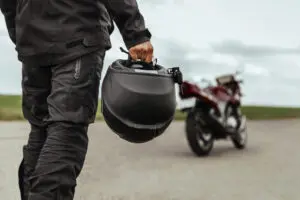Is it Safe to Ride a Motorcycle in Rain?
Is it safe to ride a motorcycle in the rain? The short answer: it depends on your preparation, skills, and decision-making. The Pennsylvania Department of Transportation reports that inclement weather contributes to a 35% increase in motorcycle accidents.
Riding in rain doesn’t just mean getting wet—it’s about managing different physics and visibility conditions. Understanding the risks of rain riding could prevent your next ride from becoming your last.
Contact Munley Law if you’ve been injured in a motorcycle accident caused by another driver’s negligence while riding in rain, such as when a car driver rear-ended you because they didn’t maintain proper following distance in wet conditions, or if another vehicle caused an accident by speeding in wet conditions. Our motorcycle accident attorneys understand the challenges these cases present.
Essential Preparation: Gear and Motorcycle Readiness
 Proper gear does more than keep you dry—it maintains comfort and concentration in wet conditions. Quality rain gear should be genuinely waterproof rather than merely water-resistant, with sealed seams and waterproof zippers. High-visibility colors and reflective panels become even more important in rain when ambient light decreases.
Proper gear does more than keep you dry—it maintains comfort and concentration in wet conditions. Quality rain gear should be genuinely waterproof rather than merely water-resistant, with sealed seams and waterproof zippers. High-visibility colors and reflective panels become even more important in rain when ambient light decreases.
Rain reduces visibility through water droplets on your visor and in the air, making it harder to see and be seen by others while motorcycle riding.
Essential rain gear includes:
- Full waterproof suits or separate jacket and pants with sealed seams
- Anti-fog helmet visor system (Pinlock or equivalent)
- Waterproof gloves with a good grip when wet
- Boots with non-slip soles and waterproof construction
Motorcycle Inspections & Bike Accidents in the Rain
Tire condition becomes paramount in wet conditions. Wet surfaces dramatically decrease traction, altering tire grip. Tread depth should be at least 2/32 of an inch, though 4/32 or greater provides significantly better water evacuation. Proper inflation helps prevent hydroplaning and improves wet traction.
Brake systems initially have reduced effectiveness when wet. Test your brakes gently at the beginning of a wet ride to understand how they’re responding. Ensure all lights function properly, as visibility to other vehicles and drivers becomes critical in rainy conditions.
Pre-ride inspection checklist for wet conditions:
- Tire tread depth and pressure are appropriate for wet riding
- Brake system components are in good condition
- All lights are working correctly for maximum visibility
- The chain is properly lubricated with water-resistant lubricant
- Electrical connections are protected from water intrusion
Critical Safety Techniques for Riding Motorcycles in the Rain
Smooth Operation and Speed Management
Smoothness becomes mandatory rather than optional when riding on wet roads. Abrupt inputs—quick acceleration, hard braking, or sudden steering—can break traction when grip is already compromised. Practice gradual, progressive application of all controls.
Reduce your dry-weather speed by approximately 30% when roads are wet; this provides more time to identify and respond to hazards while reducing the risk of hydroplaning.
Standard following distances should be doubled or tripled in rain. The “two-second rule” for dry conditions becomes a four-to-six-second rule when wet. Riding a motorcycle in the rain increases the risk of rear-end collisions due to decreased stopping distance.
Lane Positioning and Hazard Avoidance
Rain transforms minor road features into major hazards while also concealing potholes and debris on the road. Metal surfaces like manhole covers, bridge expansion joints, and railroad tracks become extremely slippery. The center of lanes often contains oil deposits, which float to the surface when rain first begins to fall. Cross hazards with the motorcycle as upright as possible, avoiding braking or accelerating while on them.
Standing water demands careful evaluation. Position yourself in the wheel tracks—where car tires typically run—as these areas usually clear faster and provide better traction for oncoming traffic. When uncertain, either avoid the water or slow significantly before encountering it.
Pennsylvania’s High-Risk Rain Riding Areas
Pennsylvania’s diverse topography creates challenges for motorcyclists in wet and cold weather. Be particularly cautious in these high-risk areas:
- Mountain sections of the PA Turnpike: The combination of steep grades, banking turns, and tunnels creates unpredictable water flow and sudden transitions between wet and dry pavement.
- Historic urban streets: Philadelphia’s cobblestone streets and Pittsburgh’s steep hills become extremely slippery and create concentrated water runoff.
- Bridges: Metal grate surfaces provide minimal traction when wet, while concrete bridges cool faster than regular roadways, making them prone to earlier freezing.
- Construction zones: Temporary metal plates, uneven pavement transitions, and altered drainage patterns create unpredictable riding surfaces.
- Rural roads: Agricultural areas often collect mud and debris washed onto the roadway, with less crown for water runoff and limited cell service if you encounter trouble.
Emergency Response: Handling Skids and Hydroplaning
 Your response in emergency situations determines whether you recover safely or crash. Some situations warrant finding shelter until conditions improve. If visibility deteriorates significantly or water begins crossing the roadway, find shelter immediately. Heavy winds can destabilize a motorcycle, especially at high speeds or on open roads. Lightning presents a serious hazard for exposed motorcyclists.
Your response in emergency situations determines whether you recover safely or crash. Some situations warrant finding shelter until conditions improve. If visibility deteriorates significantly or water begins crossing the roadway, find shelter immediately. Heavy winds can destabilize a motorcycle, especially at high speeds or on open roads. Lightning presents a serious hazard for exposed motorcyclists.
If your front wheel skids, release the brakes completely while keeping the handlebars straight, allowing the tire to regain traction. For rear wheel skids, steer in the direction of the skid while gradually releasing the throttle.
With only two narrow contact points, motorcycles are particularly vulnerable to hydroplaning, which occurs when water builds up faster than your tires can disperse it, creating a layer of water between your tires and the road.
What to do if you Hydroplane
When hydroplaning, maintain your motorcycle’s direction while avoiding sudden inputs. Close the throttle gradually without braking, allowing the tires to regain contact with the road surface. Keep your body relaxed.
Negligence and Motorcycle Accident Victims
Weather conditions affect liability determination in car accidents in several ways. Pennsylvania law requires drivers to operate at speeds “reasonable and prudent” for conditions, regardless of posted limits. If another driver fails to adjust their speed or following distance for wet conditions and causes an accident, they may bear substantial liability.
Documentation becomes critical after rain-related motorcycle accidents caused by another party’s negligence. Record weather conditions, road surface issues, and visibility factors with photos and notes. This evidence can counter insurance company tactics.
Pennsylvania operates motorcycle crashes under a modified comparative negligence system, which means compensation may be reduced by the percentage of fault assigned to you. Riding in the rain doesn’t automatically assign fault to the motorcyclist, but insurance companies often attempt to portray rain riding as inherently reckless.
Making the Right Decisions for Your Safety
Experienced motorcycle riders recognize that some rain conditions permit safe travel while others warrant postponement or alternative transportation.
Proper preparation and safe driving. With the right approach, you can extend your riding season and expand your capabilities while maintaining safety in wet conditions.
Contact the motorcycle accident lawyer at Munley Law today if you’ve experienced a motorcycle accident caused by another party’s failure to adjust their driving for weather conditions. Our experience with weather-affected motorcycle cases involving other drivers’ negligence has built our reputation among Pennsylvania’s riding community. Our free consultation will help determine whether you have a case and identify the best path toward compensation for your injuries.
Posted in Motorcycle Accidents.









